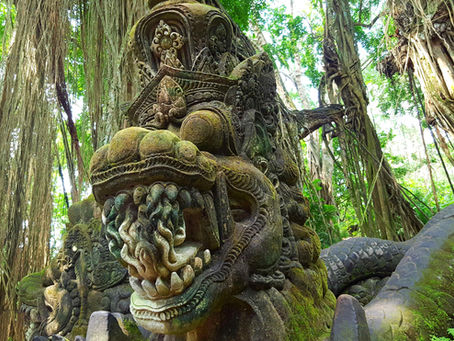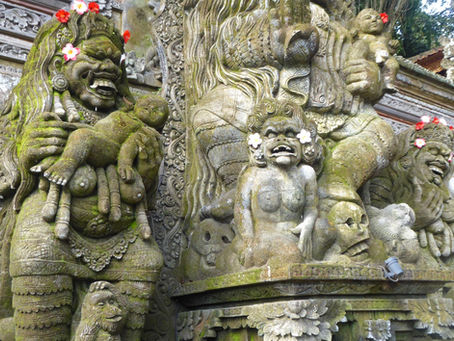top of page

GLOBAL SHANANIGANS

Search


The Telaga Waja River
The Telaga Waja River, flowing down the verdant slopes of Mount Agung in East Bali, is best known today for its rafting adventures but beneath its rushing waters lies a deep, often overlooked historical and cultural undercurrent. Historically, this river has served as both a geographical and spiritual artery for the people of Karangasem. It provides water for rice fields through a traditional irrigation system called subak and many Balinese believe it to be sacred.
Shannon


Goa Gajah Temple
Mystery surrounds the true origins of Goa Gajah, a 9th century cave temple complex near Ubud in central Bali. Rediscovered by Dutch archaeologists in 1923 after centuries hidden beneath dense vegetation, the site holds no actual link to elephants, despite its name. The term “Elephant Cave” likely evolved from Lwa Gajah, an old name associated with the nearby river, not from any animal symbolism found within the temple itself.
Shannon


The Sacred Nāgas of Bali - Guardians of the Island
In the mystical landscape of Bali, where volcanoes brood above emerald rice terraces and the sea whispers ancient secrets, serpentine beings known as Nāgas hold a revered place in the island’s cosmology. These mythical serpent deities, often depicted as long, dragon-like creatures adorned with golden crowns and shimmering scales of green and gold, are considered powerful protectors of water, fertility and the spiritual balance between the underworld, earth and the heavens.
Shannon


In the Shadow of Agung - Sidemen’s Sacred Legacy
Tucked into the emerald folds of eastern Bali, Sidemen is a village preserved in time, its quiet beauty masking layers of history, mysticism & ancient power. Long before it became a retreat for travellers, Sidemen was the cradle of sacred agricultural rituals & spiritual learning. Oral traditions trace the village’s origins back to Bali’s earliest kingdoms, once a training ground for priests drawn to the area's potent energy and its proximity to Mount Agung, the island’s most
Shannon


The Moon of Pejeng - Temple of the Bronze Drum
Pura Penataran Sasih, founded in 1266 AD, was once the state temple of the Pejeng kingdom. Set in the fertile Petauan River valley, it reflects Bali’s ancient ties between ritual and agriculture. At its centre lies the Moon of Pejeng, a 2000 year old bronze drum and the largest single-cast of its kind in the world.
Shannon


Kajeng Rice Fields Loop
Slicing through glittering, gently terraced rice fields and fringed by towering coconut palms, the Kajeng Rice Fields Walk is arguably one of the prettiest treks you can do in the cultural capital of Ubud without a guide. Kajeng offers a rare and intimate glimpse into Bali’s traditional agricultural life, set against a landscape that’s both serene and alive with quiet purpose.
Shannon


The Ogoh Ogoh Museum of Demons
Each March, as Bali prepares for the eerie silence of Nyepi, grotesque effigies of demons and witches are paraded through the streets before being set aflame. Yet not all are consigned to fire, some escape their ritual death and find a resting place in the Ogoh Ogoh Museum, a shadowy graveyard of towering statues where the spirits of chaos seem forever frozen in time.
Shannon


Sangeh Monkey Forest
Sprawled across 14 hectares of ancient forestland, Sangeh Monkey Forest, also known as Obyek Wisata Bukit Sari Sangeh, is one of Bali’s most enchanting natural sanctuaries. Towering nutmeg trees, some reaching over 40 metres tall, dominate the landscape, creating a high green canopy that diffuses the tropical light and hushes the sounds of the outside world. But what truly sets this forest apart is its origin story. According to legend, the trees were not planted, they walked
Shannon


Sacred Monkey Forest Sanctuary
Hidden among dense jungle in Ubud, the Sacred Monkey Forest is a living tapestry of Balinese culture and nature. Ancient Hindu temples rise amid towering banyan trees, creating an atmosphere of quiet reverence. The forest invites visitors to step into a world where spiritual tradition, wildlife and natural beauty coexist seamlessly, offering a rare glimpse into Bali’s enduring heritage.
Shannon


Ulu Petanu Waterfall
Tucked deep within Tegallalang village, Ulu Petanu Waterfall offers a peaceful, intimate retreat far from Bali’s busy tourist spots, where crystal-clear waters cascade gently amid dense jungle. Steeped in legend, it is also known as the sacred site linked to King Mayadenawa, whose blood is said to have cursed the nearby river, making the waterfall a place of spiritual cleansing and reverence.
Shannon


Besakih Temple
The origins of Pura Besakih are veiled in ancient legend, its story whispered through centuries beyond recorded memory. For more than a thousand years, this sprawling temple complex has stood as the spiritual heart and the “Mother Temple” of the whole island. Perched nearly a kilometre above the sea, on the jagged southwestern flank of Mount Agung, it commands a breathtaking view and an air of sacred power.
Shannon


Goa Garba and the Legacy of Kebo Iwa
Carved into a rugged cliff above the sacred Pakerisan River, this ancient hermitage and unique archaeological site offers a rare glimpse into Bali’s pre Hindu past. Hidden from view, it shelters mysterious megaliths, silent echoes of a time long before Hindu-Buddhist influence shaped the island.
Shannon


Thành Chương's Viet Palace
Tucked away on Sóc Sơn Mountain, roughly 30km's north of Hanoi, Thành Chương’s Viet Palace is far more than a museum or art gallery, it is a cultural time capsule and a living work of art, meticulously crafted by the celebrated contemporary Vietnamese painter Thành Chương.
Shannon


Jatiluwih Rice Terraces
The village of Jatiluwih offers a living testament to the ancient harmony between humans, nature and the divine. Overlooked by the brooding silhouette of Mount Batukaru, Bali’s second-highest volcano and a sacred site in its own right, Jatiluwih’s name translates to "truly beautiful," a title it lives up to with dramatic sweeps of emerald-green rice terraces that ripple across the landscape.
Shannon


The Dark Legend of Calon Arang - Bali’s Most Feared Witch
In the black veins of Balinese and Javanese mythos, no figure evokes more dread than Calon Arang. Her story isn’t just about sorcery, it’s about what happens when society pushes a woman too far and she decides to burn the world down rather than be erased by it. She was no mere witch, she became the storm of death incarnate. The widow of Girah and the devourer of life.
Shannon


The Holy Springs of Tirta Empul
Founded in 962AD during the Warmadewa dynasty, Tirta Empul is one of Bali’s most sacred temples, located in the cool highlands of Tampaksiring near Manukaya village. Its name, which means "holy water spring," is derived from a natural spring that bubbles up into the temple’s central pool and continues to feed the nearby Pakerisan River. This revered site is dedicated to Vishnu, the Hindu God of Water and Preservation
Shannon


Garuda - The Immortal Hunter
Garuda, the colossal bird being of Hindu myth, soars through Balinese religious imagination not as a gentle guardian but as a relentless force cutting across the realms of gods, demons and mortals. His wings are said to darken the sky when spread, the violent wind from their beat capable of stripping the leaves from the forests.
Shannon


The Blanco Renaissance Museum
Perched on a ridge above Ubud’s sacred Campuhan River lies one of Bali’s most curious artistic enclaves, the Blanco Renaissance Museum, once the home and studio of the flamboyant artist Don Antonio Blanco. Often called the “Dali of Bali,” Blanco's vibrant persona and sensual art helped solidify his reputation as one of the island's most celebrated foreign creatives.
Shannon


Nusa Lembongan - Bali’s Sister Island
Just 12 kilometres off the southeast coast of Bali lies Nusa Lembongan, a compact gem in a trio of islands that make up part of the Lesser Sunda chain, born from volcanic origins. Though it spans only 8 square km's, the island is a place of striking contrasts and natural beauty. Bright coral reefs encircle the island, while soft white beaches and weathered limestone cliffs shape its edges.
Shannon


Wat Chiang Man - Chiang Mai's Oldest Temple
Dating back to 1297, Chiang Mai’s oldest standing temple, Wat Chiang Man, was originally founded by King Mengrai as a royal encampment during the construction of his new capital. As the first temple within the city walls, it soon became a central hub for the emerging Lanna Kingdom, hosting religious ceremonies, political gatherings and significant social events, intertwining both spiritual devotion and civic life at the heart of the city.
Shannon
bottom of page